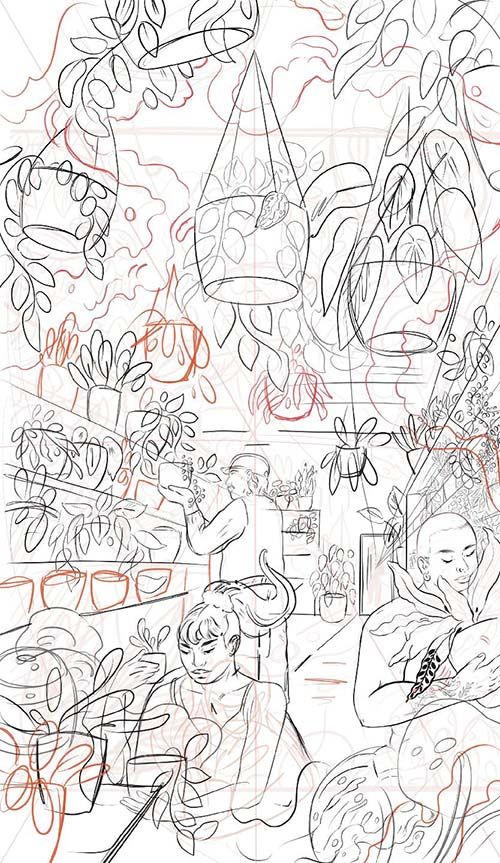Contribute Poetry
The 2025 poster series will feature a series of legendary Syracuse businesses, including Pastabilities, Hercules Candy, and Books End Bookstore. It will also include a special "reverse process" poster. For that, we've commissioned artist Katie Mulligan to create an image about Found Things Plant Shop in Eastwood (a draft of it displayed here). Poets then complement the image with a poem.
Although the deadline for general submissions has passed, we are accepting submissions of poems to complement Katie's poster through Nov. 18. You can download an entry form here.
For stories about CNY's iconic businesses, including Found Things, visit this webpage: Iconic Central New York Businesses.
If you're not already on our poet's roster, you can sign up via the Contact Us section of this website.
A note for elementary and secondary school teachers: several posters have featured student poems, and we enjoy the vision and spirit of student work. But if you have your class participate, please help with the selection work. For each class, send us the best five haiku. Thank you.

Haiku Guidelines
Haiku and other short-form poetry:
Our original call for poetry required poets to submit haiku, in keeping with the tradition of the Syracuse New Times "Syr Haikus" contest and for the form's inherent bevity. While we now welcome other short-form poetry (three- to four-lines, eight words per line, max), haiku remains popular. Whether submitting haiku or other short poems, consider these guidelines. You can also download a copy of them here.
Keep it simple:
Haiku explores simple objects, places or experiences for what’s special about them.
Draw on experience:
Like all good poetry, haiku should come from direct experience, instead of imagined or borrowed experience. Pay attention to the experiences that bring your life a moment of difference. Why did they strike you? Reconstruct the experience in words, so that your reader can see, hear and feel the same sights, sounds and physical sensations that you felt.
Write about things close by:
Write about downtown, your neighborhood, or the nearby countryside—not about places far away. Avoid writing about commercial establishments, or don’t write about them in a way that sounds like advertising.
Pay attention to nature:
Traditional haiku draws strongly on the natural world. Our haikus, coming from the city, have less opportunity to take note of nature, but you can still try. Also, traditional haiku sets the scene with allusion to the season. For example, a poet setting a scene in summer might mention crickets (or, in the city, the sound of street sweepers) as a way of evoking summer without actually naming it.
Stick to the form:
Haiku has just three lines, no titles. The first line has five syllables. The second line has seven syllables. The third line has five syllables. The form challenges you to capture the essence of an experience in very few words. Use grammar (hyphens and colons) to substitute for prepositions and conjunctions. Avoid unneeded words. For instance, poems don’t need the word “Syracuse.” It’s understood that the poems arise from Syracuse.
Use comparison and contrast:
Good haiku achieves depth by comparing two phenomena—something small and discrete with something vast, or something natural with something man-made, etc. The interplay between likeness and difference opens the reader to reflection.
Deliver a progression of effects:
Ideally, each line can stand alone. The poem should not read like a single sentence chopped into the required syllables. Finally, the last line should add a twist—a point that makes the reader wake up to your experience, and say, “Ah-ha!, yes, that’s how it is!”
Read:
From our American perspective, haiku can seem foreign and limiting. To better appreciate haiku’s history and effectiveness, read a good guide. Seasoned poets and beginners alike will find great advice from the following books:
The Haiku Handbook, by William Higginson & Penny Harter
Haiku, a Poet's Guide, by Lee Gurga.
For these and other books, visit our shopping section.
Finally, for good work by local poets, read our poetry blog.
Frequently Asked Questions
Map of Participating Poets
Wondering where our poets come from? Explore this map. You may even find that some of our poets reside in your own neighborhood. The map represents more than 800 poets, including both active poets and formerly active poets.
Testimonials
Comments from Our Poets
The artist seemed to have peered into my soul and read my words there. For perhaps the first and only time I felt that someone had actually understood what I had hoped to say in one of my poems.

I love the way that the Syracuse Poster Project highlights the things that make this city such a unique place to live. I think the Syracuse Poster Project is a really positive addition to our community, and it's something I'm really excited to be participating in.

Thank you so very much for conceiving of and nurturing this amazing project that marries poetry and art and promotes where we live! It is such a gift to our community!

After so many years, the unveiling was a great reminder of what the project does, letting people have free access to an amazing art experience on the streets of Syracuse!

I'm thrilled the posters are placed around Syracuse. It allows people to take pride in their city and it brings a little color and inspiration for all to enjoy.

I enjoy submitting poetry every year and have always liked the idea of dressing up the City of Syracuse with poetry and art. We need more positivity in this country and anything uplifting is welcome.

